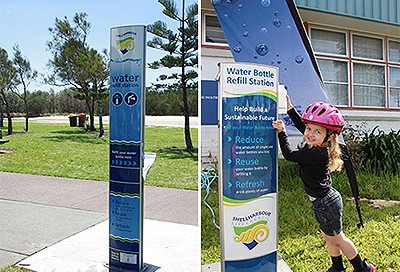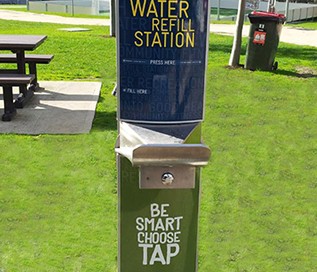Our Aquafil® drinking water fountain and refill stations are popular with architects and city planners for a number of reasons. They encourage a healthy lifestyle, offer useful amenity for the public and can become defining feature points of any civic space.
Here are ten key reasons why architects should choose an Aquafil® product for their next civic project:
- A convenient source of great-tasting drinking water
Our product provides access to clean, safe, accessible drinking water. Why is that important? Because architects specify the amenities that affect the user experience, and making free drinking water available to the public is a wonderful amenity. Tap water in many parts of Australia is notorious for having a bad rep, even though it’s generally safe to drink. Many Aquafil® stations also include water filtration to cater for this.
- A place to gather at
Aquafil® drinking fountains and refill stations are great at providing a focal point for people to meet and gather. Our signature range of water drinking fountain and bottle refill stations also include signage panels, creating a distinctive and easily recognisable feature in any public space.
- Aesthetics
Our product line offers a range of designs to choose from. Architects can select from our wall-mounted Fresh Refill Station and Drinking Fountain range to our more unique Alpine Double Water Refill Station. Our designs are modern and practical, making them great additions to schools, universities, medical centres, and outdoor public spaces.
- Functionality
Architects choose our Aquafil® products because they are functional and well designed. Our signature line of water stations have been designed, engineered and assembled by our team in Sydney, and our years of experience in the industry is testament to our success.
- Environmentally Friendly
Our product line of refill stations encourages the use of reusable water bottles over single-use bottled soft drinks and water products. Single-use plastic drinking bottles is an inefficient way of delivering drinking water and has become a burden on our environment; the majority of plastic bottles are not recycled and end up in landfills every year. Australia alone spends more than half a billion dollars a year on bottled water. Having our line of drinking fountains and refill stations easily accessible can help alleviate our large use of plastic bottled water.
- Educational
Aquafil® stations are a great way of teaching environmental awareness. They facilitate the use of reusable bottles and encourage drinking more water over sugary soft drinks. Our stations incorporate customisable signage panels that help communicate this.
- Economical
Using a drinking fountain and refill station can save a person a lot of money. Architects love using our products because they provide a way for their users to save money on purchasing bottled drinking water or soft drink.
- Inclusiveness
Aquafil®’s products are easily accessible by anyone who needs it. Most of our range are child- and wheelchair-friendly, with DDA compliance. Our products have multiple points of access, and we have products suited to indoor and outdoor applications. And for pet lovers, we even have an added option of a dog bowl!
- Ergonomic
An architect also has to consider a person’s comfort when using their facilities and the items on it. That’s why they choose Aquafil®. Our drinking fountains are easy to reach, with buttons that are durable and comfortable to use. We have spent a lot of time developing suitable valve technology to make the product as long lasting and easy to use as possible. Our refill stations also provide ample space to put your water bottle in and work wonderfully.
- Taste
Our product offerings are also popular with architects because of the great taste of the water. Our optional filtering systems and anti-bacterial nozzles ensure that the water that comes out is clean, fresh, and tasty. A lot of time, tap water can have odd flavors due to the chemicals used as a disinfectant. Our additional layer of filtration removes all the impurities from the water so that it tastes like water and nothing else.



